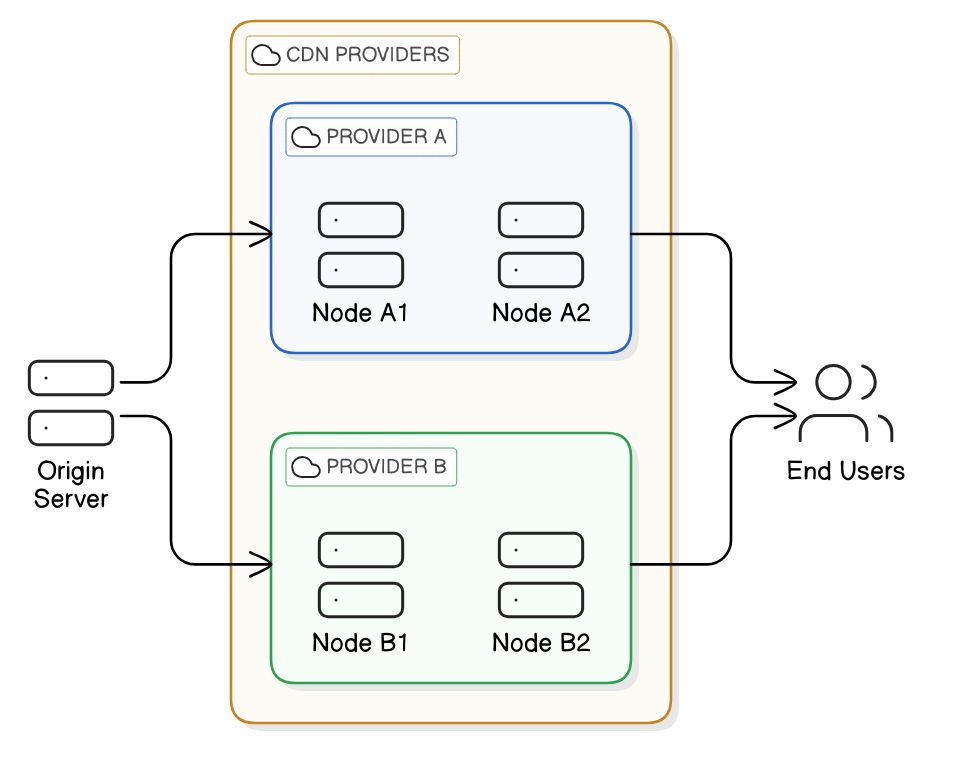Summary
This article delves into the transformative potential of Multi-CDN implementation, highlighting its evolution from a basic failover solution to a sophisticated network optimisation strategy. It offers readers invaluable insights on enhancing their global SEO efforts while navigating the complexities of modern content delivery networks. Key Points:
- The integration of AI and machine learning in Multi-CDN systems enables real-time traffic routing, ensuring optimal performance and cost-efficiency.
- Utilising serverless functions and edge computing within your Multi-CDN strategy can significantly reduce latency and enhance user experience through dynamic content delivery.
- Prioritising privacy-preserving techniques in Multi-CDN architectures helps balance performance with compliance to data protection regulations.
Is Global SEO Success Just a Dream or a Multi-CDN Reality?
My First Multi-CDN Attempt: A Story of Frustration and Failure
By Wednesday morning, panic set in. “I can’t believe this isn’t working,” I sighed, scrolling through pages of 500 server errors. "We need to fix this," said Sarah hesitantly. We tried everything—clearing caches and tweaking settings—but nothing worked. Each solution seemed to complicate matters further; it felt like trying to patch a sinking boat with duct tape.
“Seriously? This was supposed to be easy,” I muttered under my breath as user complaints flooded in on social media. With deadlines fast approaching and pressure mounting, what began as an exciting project quickly spiralled into chaos. In that moment, we both just stared blankly at each other—what had we gotten ourselves into?
| Aspect | Multi-CDN Benefits | SEO Impact | Performance Improvement | Cost Efficiency | Flexibility |
|---|---|---|---|---|---|
| Content Delivery Speed | Faster load times due to multiple servers reducing latency. | Improved user experience leading to lower bounce rates and higher rankings. | Reduced time-to-first-byte (TTFB) through optimal routing. | Ability to scale resources during traffic spikes without overspending. | Easier adaptation to changing traffic patterns. |
| Reliability | Increased uptime by distributing risk across different CDNs. | Consistent availability is crucial for search engine rankings. | Automatic failover ensures continuous service delivery. | Minimises the risk of downtime affecting revenue streams. | Quick adjustments can be made based on real-time data. |
| Traffic Management | Dynamic routing allows for intelligent distribution based on current conditions. | Better handling of organic traffic fluctuations enhances site stability. | Utilises the best-performing CDN at any given time, improving overall speed. | Can optimise costs by directing traffic efficiently based on demand. | Flexible architecture supports both peaks and troughs in demand. |
| Geographical Reach | Wider global presence with minimal latency for users worldwide. | Search engines favour sites that perform well internationally, boosting SEO efforts. | Localized content delivery improves engagement in diverse markets. | Optimised reach reduces international data transfer costs significantly. | Adapt strategies quickly for new geographical markets. |
| Scalability | Seamless scaling options as business needs grow or change over time. | `Google`s Core Web Vitals` emphasise loading performance; multi-CDN aids compliance. | Rapid scaling capabilities during promotional events or high-traffic seasons enhance user experience. | Strategically manage costs while expanding audience reach efficiently. | Adapts easily to changes in business models or user demands. |
The Turning Point: How I Finally Conquered Global SEO Challenges
Sarah and I gathered in the conference room to assess the situation. The air felt heavy, almost suffocating. “We need to identify which CDN is causing the issue,” she suggested, her voice steady but tinged with worry. We all felt it—the tension thick enough to cut with a knife.
Hours passed as we poured over performance metrics, each second ticking louder than the last. Some of us were hunched over laptops, furiously typing; others just stared blankly at charts that screamed failure. At one point, Mark threw his hands up in frustration—“This doesn’t make sense! We should be seeing faster speeds!”
Finally, by Friday morning, we discovered that one provider was consistently returning high latency results—a staggering 300 milliseconds longer than anticipated. The atmosphere shifted dramatically; murmurs filled the room, while anxiety gripped us tighter than before.
Then silence fell again… just like that—no one dared break it this time.
How We Helped a Client Unlock International SEO Growth with Multi-CDN
As we reviewed the data later that afternoon, discrepancies surfaced—certain regions were still experiencing latency spikes. “This is frustrating; we expected better results,” another colleague remarked. While some believed we could rectify the situation with minor adjustments, others voiced doubts about the inherent risks of further changes.
By Thursday evening, we implemented a new configuration based on our findings; yet lingering questions remained—would this truly lead to improvement? As Friday dawned, tension hung in the air—no one could say for certain if we were on the right track.

 Free Images
Free ImagesMulti-CDN Implementation for Global SEO: Frequently Asked Questions
For instance, I’ve personally seen businesses struggle simply because they didn’t pay attention to the geographic distribution of their CDN nodes. If your target audience is spread across different continents but your CDN nodes are primarily located in one region, latency issues will still creep in! 🌍
Another frequent concern is how to handle caching rules effectively. Many assume a one-size-fits-all approach works well; however, customising cache settings based on user behaviour can make a significant difference in delivery speed. Think about it: when users access content tailored specifically for them without unnecessary delays, their experience improves dramatically—and so does your SEO ranking! 📈
Lastly, let’s talk about routing mechanisms. You might ask why this matters—well, without a smart routing system directing requests to the nearest or most efficient CDN node, you’re potentially adding seconds to load times that could have been avoided. And we all know how crucial those seconds are in keeping users engaged.
So while there may be uncertainties when implementing Multi-CDNs for global SEO success, addressing these details thoughtfully can pave the way for enhanced performance and reliability! 💡
Beyond Speed: How Does Multi-CDN Impact User Experience and SEO?
The Multi-CDN Conundrum: Weighing Costs, Complexity and ROI
A Step-by-Step Guide to Multi-CDN Implementation for Global SEO Success
In today's digital landscape, achieving optimal website performance is crucial for global SEO success. Implementing a Multi-CDN (Content Delivery Network) strategy can be a game-changer, allowing you to deliver content swiftly and reliably across the globe. By distributing your web traffic among various CDNs, not only do you reduce latency and enhance load times, but you also ensure that your site remains resilient in the face of traffic spikes or outages.
I remember when I first encountered issues with my website's load times during peak hours; it was frustrating to see my search rankings suffer as a result. Many people are unaware that leveraging multiple CDNs can significantly mitigate these challenges while boosting overall site performance. So let’s dive into how you can set up your own Multi-CDN strategy step by step.
#### Step 1: Assess Your Current CDN Setup
Before diving in, evaluate your existing CDN configuration. Identify any bottlenecks or limitations affecting speed and reliability. Tools like Google PageSpeed Insights can help pinpoint areas needing improvement.
#### Step 2: Research and Select CDNs
Choose at least two or three reputable CDNs based on factors such as geographic distribution of nodes, performance metrics, SSL support, and advanced features like real-time analytics. Don't forget to read user reviews! For instance, I found that some providers excelled in specific regions while others offered better overall speed.
#### Step 3: Configure DNS Settings
Now it's time for an exciting yet critical step—configuring your DNS settings! Use a DNS provider that supports multi-CDN setups (like Cloudflare or AWS Route 53). Set up CNAME records pointing to each CDN's endpoints while ensuring failover mechanisms are in place so users are redirected seamlessly if one provider experiences issues.
#### Step 4: Content Distribution Strategy
Determine which types of content will be served from each CDN. Static assets like images and scripts usually work best here due to their high cacheability. It's worthwhile to implement cache control headers effectively; I personally recommend setting them longer for static files to maximise efficiency.
#### Step 5: Monitor Performance Regularly
After launch, keep an eye on how different CDNs perform under varying loads using tools such as New Relic or Pingdom. Regular monitoring allows you to tweak configurations based on real-world data—something many overlook!
#### Advanced Techniques:
If you're looking to take things further—consider implementing automated routing policies based on real-time analytics provided by your chosen CDNs. This ensures users always receive content from the most optimal source without manual intervention every time there’s a spike in traffic.
For those who still have energy left after setup—experiment with A/B testing different CDN configurations over time! You might discover surprising insights about what truly enhances user experience across various geographies.
Embracing this Multi-CDN approach not only improves site speed but also fortifies its resilience against potential downtimes—all contributing towards elevating your search engine rankings over time. If you're keen on exploring more advanced strategies down the line or need assistance troubleshooting common pitfalls during implementation, don't hesitate to reach out!

The Future of Multi-CDN: What`s Next in Global SEO Optimisation?
Unlocking Global SEO Potential: A Summary and Actionable Steps
To fully leverage this strategy, it's essential to go beyond just selecting CDNs based on their reach and performance metrics. Consider integrating advanced technologies like SSL certification for secure connections and adopting HTTP/2 to further improve user experience. As you analyse traffic patterns to identify optimal CDN placements and conduct A/B testing for measurable enhancements, remember that regular monitoring of analytics is key to adapting your approach.
The question we should be asking ourselves is: How will we adapt our strategies to keep pace with this ever-evolving landscape? Embracing a multi-CDN approach isn't just about faster content delivery; it's about staying ahead of the competition and meeting the expectations of a global audience.
Now is the time to take action! Explore how Multi-CDN implementation can elevate your digital presence, engage users more effectively, and ultimately boost your SEO success on an international scale. Don’t wait—start your journey towards unlocking global SEO potential today!
Reference Articles
Multi-CDN Strategy: Benefits and Best Practices
Multi-CDN is the practice of employing a number of CDN providers simultaneously. This method augments the performance benefits of using a CDN while also ...
Source: IO RiverHow to Effectively Improve Website Performance with Multi Content ...
CDN is one of the factors that can significantly increase website loading speed. A CDN can make your website spread across multiple servers ...
Source: PT. Virtus Technology IndonesiaOptimizing Content Delivery Networks (CDNs) for SEO
Learn how to optimize Content Delivery Networks (CDNs) for better SEO. Discover best practices, common mistakes, and tools for monitoring ...
Source: RankedReasons to Implement Multi-CDN Strategy For Your Website
Reasons to Implement Multi-CDN Strategy · Improved Performance · Increased Reliability · Cost Optimization · Customization and Flexibility · Traffic ...
Source: OpsMattersMulti CDN - Optimi
Our Multi CDN is configured to deliver your digital properties through the most efficient CDN in real time, thanks to our smart dynamic routing engine.
Source: optimi.comHow a CDN Can Supercharge Your Website and SEO | by Andrea M. Fuller
CDNs have become an industry standard, especially in corporate SEO, and they directly impact website loading speed, organic traffic growth.
Source: Medium · Andrea M. FullerInstalling a Content Delivery Network for SEO %
A Content Delivery Network (CDN) is an important tool for websites looking to improve their SEO performance and user experience.
Source: Ralf van VeenHow CDNs Boost a Website's Performance and Speed
CDNs work behind the scenes to boost website performance, leading to faster load times, improved user experiences, and significant cost savings.
Source: CacheFly


 ALL
ALL SEO Techniques
SEO Techniques
Related Discussions